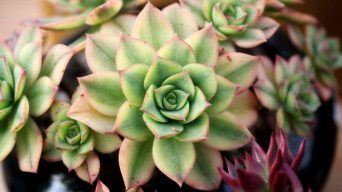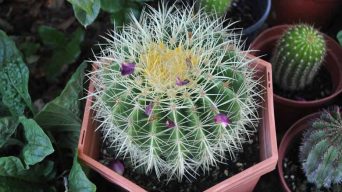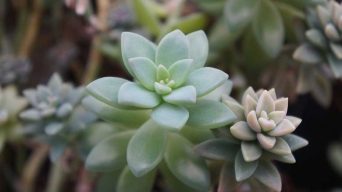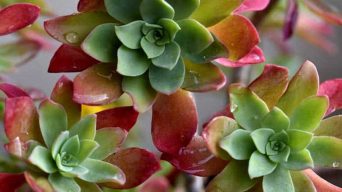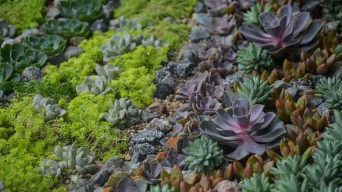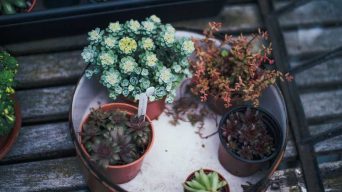If you are a succulent owner, then one of your most common worries is whether or not your plant is healthy.
But how to tell if your succulent is healthy? The easiest way to know if it’s happy and healthy is by looking for certain signs that your plant displays.
These include lots of new growth, green leaves and no brown spots on them, and an even soil color.
Here we will discuss how to recognize the signs of a healthy succulent and how to keep your succulent looking its best.
How Do I Know if My Succulent Is Healthy?
It’s essential to learn how to tell the difference between a happy succulent and one that needs attention.
Here are some ways to recognize if your succulent is healthy and what you can do about it if not.
Healthy Roots
A succulent with a strong root system will have fleshy white roots free of any yellowish discoloration or spots from leaking sap.
The roots should be long, large, and spreading out in all directions.
The succulent with a weak root system will have small roots that are unable to support the plant.
If your soil is compacted or too dense for good drainage, this may result in poor rooting and low nutrient absorption by the plants.
A healthy succulent has about 12 inches of solid roots, growing up to one foot per year.
The following symptoms could indicate a problem with the root system:
- Dry and shriveled roots
- Roots that are broken or rotten
- Decayed roots with moist, dark spots on the surface
- Poor growth and yellowing leaves.
- Discoloration on succulent leaves
- A lack of new growths.
In general, if a cactus or succulent is healthy on all other levels, then it can be treated using these methods:
- Provide increased ventilation by opening windows more often during hot days when rain isn’t expected. This will dry out stagnant air causing fungus to grow worse and limit oxygen availability for the plants, contributing to root rot. Alternatively, place a fan near the plant to disturb it too much from its original placement since moving it around may disrupt it even more.
- Water the succulent less than usual to help limit rot from stagnant water and provide evaporative cooling properties that will keep it a little healthier for longer. Too much dryness can lead to desiccation, so make sure you don’t do this too often or for prolonged periods (like weeks). You may also use an air humidifier nearby your plant if needed.
- During times of high humidity, you can apply a fungicide containing chlorothalonil every few months as a preventative measure. But it should not be used on plants already suffering from root rot because it could worsen the damage done by fungal activity in roots.
- If your succulent is potted in potting soil with coniferous bark or perlite, you can often alleviate the dryness by watering more frequently. When it’s planted directly into the ground, or its container doesn’t contain any of these materials to help manage moisture content, you may need an epiphytic tree fern. It does well at retaining water and should be placed next to your plant so that they can soak up some of the evaporated moisture from leaves and stems.
- You might also want to consider adding a layer of gravel on top of the soil around roots for added drainage. Sometimes, succulents are prone to root rot due to poor drainage conditions. This will allow air to circulate, the water will be able to penetrate through potting soil or gravel more easily, and there is less chance of root rot.
- Lastly, you may want to consider using a porous material like charcoal to aid in drainage surrounding roots. It works well at attracting moisture outwards away from the plant’s roots while still allowing air circulation around those same roots. It also doesn’t restrict sunlight from reaching your succulent foliage, which can happen with some other materials typically used for this purpose, such as sand or perlite.
Healthy New Growth
When a succulent is happy and healthy, it will show new growth.
Flowering plants may have more blooms when they’re feeling good. If the plant has spines, it will have longer or wider leaves and thicker in texture.
Plants use up all their energy making new leaves when they’re happy.
Healthy succulents produce a second set of plump and green leaves on the underside with lighter coloration around their edges where they meet the soil.
You can expect to see at least two sets of new growth per year on most succulents.
Some common problems that may be preventing new growth are:
- Too much water or not enough. Succulents need to be watered each week, but only the amount of water they can absorb at that time, but this will vary from plant to plant. If you’re using a garden hose or watering bucket, aim for about an inch per day and monitor how it’s drying out in between soaks.
- Not enough light. For plants indoors, place them near windows where there is plenty of sunlight during most hours of the day, or invest in grow lights specifically for your succulents.
- Too much sun. Succulents are happiest in bright indirect light. If you’re looking to grow them on a windowsill or outside near the heat of the midday sun, pick ones that can handle more sunlight, like Jade varieties.
- Disease and pests. Brown spots on leaves or yellowing means there is an issue with water flow through roots or too much salt present (from tap water). Check for aphids by rubbing some leaves together; they will often leave a sticky residue behind. If left untreated, these issues may lead to other problems such as root rot, which could entirely kill the plant.
- Watch for drooping leaves or stems. Too much moisture in the potting soil may mean that it might be time to repot your succulent.
Healthy Leaves
Healthy succulents have dark green, smooth leaves.
The leaf edges are not curled, and the tips of the leaves do not turn brown or dry out as they age. The color on the upper surface should be uniform (except variegated types), with no dead areas.
The most common way to check if a plant is healthy and happy is by looking at the color. But, In succulents, not every change in leaf color is a bad sign.
Healthy succulents have many colors on their leaves. Some of these colors will create stripes, spots, or bands in the full-grown leaf. These variations don’t mean that your plant is unhealthy.
If you have a variegated succulent, then the color variations will be more pronounced than if it were only one solid green shade.
These plants are usually considered rare and very desirable because they’re so unique-looking. The various colors may also represent patches of dead leaves on your plant that haven’t yet dropped off.
An unhealthy succulent will show the following signs on its leaves:
- Leaves turning yellow, orange, or brown
- Leaves showing spots of dead leaves along the edge
- Leaves with holes
- Leaves curling down
- Leaves turning black and dying off
If your succulent continues to display any of these signs, you should take it out of the sun immediately, so its leaves stop getting worse or drop off altogether.
It may be a sign that too much heat is damaging the plant’s cells while trying to photosynthesize.
Other possible causes of an unhealthy succulent are low water levels, over-fertilizing, or not enough light.
If you’re unsure which one might be the issue, try watering it more and give it less fertilizer or vice versa to see if your plant improves. You may also want to place a grow lamp near its leaves for a few hours to help give it more light.
Compact and Robust Succulents
A healthy succulent should be full and have leaves that start from the base of the plant and are closely spaced.
Succulents are often called “compact” because the leaves grow closely together and can seem to be bunched up.
Compact and robust succulents will have narrower leaves than more delicate plants. They might also be denser in how they grow, with thick rosettes of leaves. It’s common for these types to grow layers or tiers on top of one another.
When a succulent grows uneven, and with spaces between its leaves, it can be a sign of:
- Overwatering
- Not enough water and/or too much light
- Low temperature
- High temperature
- Draught of air or wind
- Lack of nutrients
- Pests or diseases
When your succulent is not growing compact and robust, you can treat it with the following methods:
- Allow the soil to dry between waterings
- Decrease light exposure
- Increase air movement around your plant or use a fan for more direct airflow, which can help avoid draught.
- Sprinkle with fertilizer at least once a month (or every two weeks during peak growing season) to provide it with necessary nutrients.
- Protect it from pests and diseases by spraying the leaves with a diluted mixture of water, dish soap, and hydrogen peroxide.
- You can also let your succulent rest during its dormant period to allow time for previous damages to heal or recover.
- Allow your succulent to go through periods of drought for it to become stronger.
- Move your succulent into a shady area if possible during hot months and bring it back indoors when temperatures cool down again. This should be done gradually so that plants won’t get too stressed out from the change in temperature (this could cause them stress).
Healthy Stem
A healthy succulent should also have a thick, strong stem that supports it.
The best way to recognize this is by checking for signs of bruising or damage on the plant’s stem near its base. If you see bruising or a break in the stem, this is an indication that your succulent needs more water and nutrients.
To check the health of the succulent’s stem, you have to:
- Check around where the soil meets the roots (the “phyllo”) at different points along each branch/stem for signs of rot or a grayish-green mold.
- Check for any unusual bumps, leaves falling off the plant, and overall health/coloration compared to other plants.
If it’s not clear if there has been any damage to the plant, try gently pulling on its base and checking for resistance. Healthy plants should pull away from their pot but will still be firm. If they are too loose, this can indicate dehydration, so check your watering routine.
A weak stem can be a sign of over-watering, so make sure you are watering your succulent regularly and don’t water it too often.
A weak stem can also be a sign of the wrong type of plant pot or soil so before you know it, see if your succulent has been planted in the right kind of container for its needs.
If there has indeed been damage to the plant but is still salvageable, then follow these steps:
- Reduce exposure to sunlight – this will cause more leaves to fall off
- Stop fertilizing until new growth begins again
- Check for any bugs near the roots/stems (but not on them), which could indicate an infestation. If found, then use neem oil to kill the bugs
- Add a layer of sand to the top of your soil for good drainage and aeration.
It Has No Pests or Diseases
If your succulent is healthy, it should have no pests or diseases. There are a few different pests that can infest plants and cause damage to them, like aphids.
But suppose you’ve been making sure to water the plant regularly and fertilize when needed. In that case, these minor issues shouldn’t be present on an otherwise healthy succulent.
f there is any evidence of pest activity, this could indicate that something might need changing in how often you care for your succulent’s needs.
The main way to tell if one’s succulent has pests or disease would be because it isn’t doing well.
The leaves may look dryer than usual, more wilted with brown edges rather than the normal bright green color, or the succulent may have spots on them.
If you notice anything like this, it’s crucial to take action and make sure none of your other succulents are infected.
How To Keep Succulents Happy?
Some essential tips are of great help to keep your succulents healthy and happy.
Water and Soil
Though succulents are drought-tolerant, they still need to be watered often for the best results.
To not over or under-water your succulent, you should use a light soil such as a cactus mix.
It will help absorb any extra moisture but at the same time provide enough drainage, so the excess isn’t retained in the pot.
Light
Succulents need bright, indirect light. They do not require full sunlight.
The best light is mostly from the window without direct sun exposure to avoid burning the leaves and scorching their surface.
Temperature
Succulents are sensitive to temperature and will not tolerate frost or extreme heat.
Temperatures between 65-90F degrees would be ideal. Within this range, the succulent should do well with little care given.
They can even survive brief periods of temperatures below 40 degrees if they have a chance to warm up again before freezing.
Final Thoughts
There are a few different ways to tell if your succulent is healthy and happy.
Whether it be how well they’re growing or the color of their leaves, you can tell if your succulent is healthy and happy by paying close attention to its life cycle.
There are a few different ways you can support the health of your plant, so make sure you’re taking good care of it!


